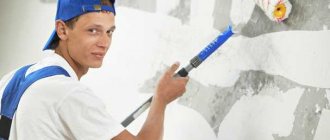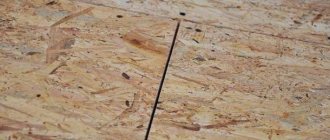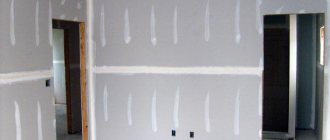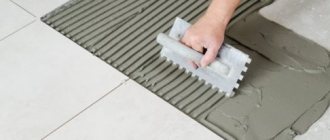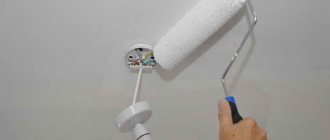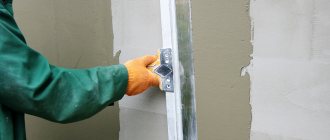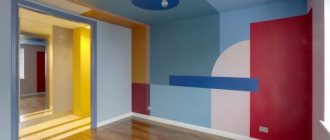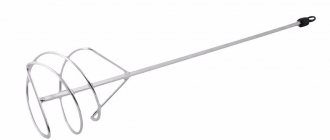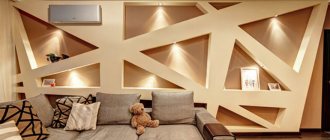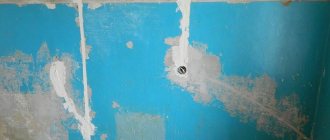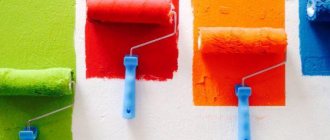A layer of putty applied to the surface of the ceiling or walls during repair work is of great importance, since exceeding the permissible parameters will lead to peeling of the material.
It all depends on what mixture is used and what surface the putty is applied to. To level the walls, a structure is constructed from plasterboard, which hides the most significant defects. And it needs to be puttied, especially if paint is used as a finishing coat. All other materials must be puttied, applying several layers of the mixture.
Which putty is best for drywall?
After you have covered a wall or ceiling with plasterboard sheets or made a plasterboard structure, you need to proceed to a very important step - putty.
In addition to the fact that the wall needs to be properly puttied, you also need to choose which putty is best for drywall in your apartment. There are many types of putty material, which differ in different parameters. Before choosing which putty to putty on drywall, it doesn’t hurt to familiarize yourself in detail with all the possible options in order to make the right choice, which you won’t have to regret after the renovation is completed. What is this article about?
When can you start gluing?
After sanding the surface, you need to clean the walls from dust with a brush and dry rag.
This is done with a vacuum cleaner at first speed. After cleaning the wall, it must be coated with a primer. After drying, it will leave a thin film that will protect the glue from being absorbed into the surface. When the primer is completely dry, start working on the wallpaper.
Having studied all the subtleties of choosing a putty, the surface will be perfectly smooth and durable. You should not miss small nuances from the work; they play an important role in the formation of a solid wall for wallpaper.
Walls with putty and wallpaper have an attractive appearance and a long warranty period.
Why do you need putty?
The ability to understand the types of putty for drywall will be useful not only to professionals and repairmen. Knowing about the types of putty mixtures, you will not have to turn to professionals for help, and will be able to carry out finishing repairs yourself.
Perhaps you are just planning a renovation and don’t yet know whether you will need putty. If you are installing a gypsum board wall, you will need to putty it in any case, at least once. There are often cases when it is necessary to apply two or three layers of putty. So in any repair using plasterboard sheets you will have to use putty.
To carry out puttying work you need putty. What is she like? This is a special fast-hardening material. It is intended, as a rule, to level the wall. And also putty is simply necessary in order to carry out the final finishing of the wall with decorative materials. Therefore, putty is a necessary element of finishing a plasterboard wall, which in no case can be excluded.
How to clean the tool
There are many videos and articles on this topic on the Internet. But these two options are considered to be the most common.
- make a couple of slits in a tin can, and in the end you will have an accessible and effective device for cleaning tools;
- arm yourself with a wet rag (to prevent dust from appearing) and an ordinary washcloth to clean scale from stainless utensils.
For effective cleaning, you just need to delicately treat the contaminated surface with iron filings.
It is rational to use a wet rag to brush away falling dust particles. After a few minutes of manipulation, the instrument will look like new.
Even old, long-hardened putty can be easily cleaned in this way. Some people recommend using sandpaper, but it can damage the delicate surface of the spatula. This method can only be used by professionals who know how to control the intensity of friction.
Types of putty
At the moment, in any country and in any city you can find a wide variety of putty materials of any kind. In addition to types and purpose, putty materials vary in price and quality. It all depends on your choice. Calculate based on your budget. As a rule, you should not trust cheap materials that pretend to be analogues of more expensive putties. It is much better to purchase material from a well-known brand that has already earned trust and respect. By the way, the cost of putty depends not only on the price, but also on the consumption per 1 m2. We will consider which putty to choose for drywall in a given situation will be most reasonable.
It is very important to remember that life does not stand still. If you are an experienced craftsman and are familiar with famous brands that were popular ten years ago, then keep in mind that all modern manufacturers are several times superior to the old ones in many ways.
So, there are several parameters by which types of putty are distinguished. Let's look at each one separately.
Types of putty by purpose
There are three types of putty mixtures, depending on the type of application.
- Leveling putties;
- Universal mixtures;
- Finishing putties.
Finishing putties for plasterboard walls are usually sold ready-made and do not require dilution of the powder. They are applied to the plasterboard wall as the final layer. All that remains to be done after finishing the wall with finishing putty is to wipe it with scratch paper. After this, they begin decorative finishing - painting, wallpapering, and the like. All variations of finishing putty do an excellent job, namely, they repair all errors, cracks and other defects on the wall.
Leveling mixtures are designed to seal all seams, holes from screws and similar irregularities on the wall. This putty is needed to level the wall and is not carried out at the finishing stage. Roughly speaking, this is rough work on processing the wall.
The universal putty can also be used to level other types of surfaces. The uniqueness of this variation is that it can be used both as a leveling putty and as a finishing putty. However, it is recommended to use putties of this type only for initial rough work. The reason lies in the fact that universal mixtures have a grainy consistency, due to which the putty is not suitable for preparing the wall for painting or wallpapering. However, this type of putty is perfect for subsequent installation of tiles or decorative plaster.
Types of putty by composition
Putties also differ from each other depending on the materials from which one or another mixture is made. There are three main types of putty based on composition.
Gypsum putties have a high-quality composition and are superior to cement ones in that they are completely resistant to shrinkage. Gypsum putties include the well-known KNAUF, which is also used as an adhesive when installing plasterboard walls. This putty has a significant disadvantage - poor moisture resistance. Because of this, putty cannot be used in bathrooms and other rooms with high air humidity. In other cases, high-quality gypsum putty is an excellent option.
As a rule, when working with drywall, gypsum putty is used!
Cement putties are significantly inferior to gypsum putties due to the fact that they are highly susceptible to shrinkage. However, cement putty is more stable compared to gypsum analogues. In addition, cement putty easily withstands mechanical stress.
Polymer putties are better analogues in composition. These are the most universal mixtures that combine all the advantages of gypsum and cement options due to the combined structure of the composition. They are suitable for use in any room and under any conditions, are resistant to mechanical stress after complete hardening and are completely resistant to shrinkage. Thanks to all these advantages, the most reasonable choice would be polymer putty, however, the price of such a mixture is much higher than its cement and gypsum counterparts. Therefore, if you do not have an unlimited budget, you can choose a putty between gypsum and cement, based on the situation, rather than purchasing a polymer mixture.
It is worth reminding yourself that, despite the moisture resistance of the putty, you can never do without a primer. If you are renovating a bathroom and using a gypsum or polymer mixture, you will still need to prime the wall. In rooms where air humidity is low, you can use cement putty, but a primer is still needed.
Types of putties according to readiness for use
There are only two such types: dry and ready-made putty. Let's figure out how they differ from each other.
Dry putties are powder mixtures that must be diluted in water before use according to the instructions indicated on the package. The advantage of dry putties is that they can be stored for a long time. If you don’t dilute all the powder in water at once, then the remains can be saved for later to seal cracks whose appearance could not be foreseen, for example. The downside is that after dilution, the putty must be used immediately before it dries.
Ready-made putties are thick mixtures that need to be immediately applied to the wall. They do not require additional stirring and are sold immediately ready-made. The disadvantage of these putties is that they cannot be stored for a long time. But despite this, they have a longer shelf life in finished form, unlike dry powders. In addition, you do not have to dilute any powders. You can start working immediately after purchase.
It is worth noting one important detail. By purchasing a dry mixture, you can make it thicker or thinner, at your discretion. Although it is usually recommended to follow the instructions exactly, if you have enough experience in repair work, you can determine in which situation it is better to achieve a particular consistency.
Putty VDAK “Faktura” for wood TU 2313-004-51309101-00
- GOST, TU: TU 2313-004-51309101-00
- Manufacturers: OOO "Palitra Rusi"
- OKP code: 2313941001
Characteristics
- Color: white, beech, walnut, rowan, pine.
- The base is acrylic dispersion.
- Drying time at +20°C and relative air humidity 65%: before sanding - 2 hours, before painting - 8 hours.
- Application temperature - from +8°C to +35°C (preferably from +15°C to 25°C) and relative air humidity no more than 75%.
Scope of application: Technological, durable putty for high-quality finishing of wooden products, including windows, doors, furniture. Designed for leveling irregularities of various origins: chips, cracks, knots, joints of elements, buried fasteners, etc. Can be used both for continuous puttying and for repairing small areas of surfaces. White putty is intended for painting with opaque compounds, colored putties are intended for varnishing.
Description: Easy to apply, does not give shrinkage cracks in the layer up to 3 mm, dries quickly, sands well. Has high adhesion to wood and other porous substrates. Weather-resistant, does not crack due to temperature changes, has antiseptic properties and good water resistance. Ecologically complete, fire and explosion proof, practically odorless. Consumption: from 0.5 kg/m2.
Application method: Before use, mix the putty thoroughly and, if necessary, dilute with water by no more than 3%. The surface to be coated must be dry and clean. Pre-prime untreated wood with antiseptic primer “For wood” or with porosity-filling primer “For windows and doors” Profi or Hobby. The putty is applied with a spatula in 1-2 layers, depending on the size of the defects.
Tools for working with putty
It is very important to use the right tools when working with different types of putty, which are best suited for a given situation. This may seem like a minor aspect at first glance, but it is actually very important.
There are two different types of spatula that are used in different situations during putty - wide and narrow. Branded spatulas are better suited for the job than others, they even make the work less labor-intensive. A wide spatula is used for basic work, and a narrow one is an auxiliary tool for situational situations.
And it’s also worth remembering that if you use dry putty, then in some cases you need to use water to dilute the mixture, and in others you need to use a primer. Be careful with this aspect and always follow the instructions carefully.
If, after leveling the wall with putty, it is still not level enough, you can use a special aluminum profile. It is used to straighten curved non-plasterboard walls. Together with putty, it can even out any unevenness in different walls. This same aluminum profile is frozen vertically along the primed surface along the entire wall, and after that a layer of putty is applied. In this process, the profile serves as a support.
Question 5: how to properly prepare putty from a dry mixture
In general, cooking instructions are always on the package.
The photo shows the packaging of Eurogypsum putty. On the back of the bag there are detailed instructions for preparing the mixture.
However, there are several universal recommendations:
- When mixing gypsum putty, you need to add the dry mixture to the water, and not vice versa. If you pour water into a container with a mixture, dry lumps will form at the bottom, which are almost impossible to break up when kneading;
- You can mix a small amount of putty to seal joints in drywall with your own hands using a spatula. But you need to prepare a large amount of the mixture to level the walls with a construction mixer: this is the only way you will achieve uniform mixing of the putty throughout the entire volume;
If you don't have a mixer, use a drill or hammer drill with a whisk.
A whisk clamped in a drill will replace your construction mixer.
- Before preparing a new batch of putty, thoroughly wash the dishes, tools, and mixer whisk. Otherwise, lumps falling under the spatula will not allow you to make the wall surface smooth.
Surface Condition Assessment
The complexity of the final stage of finishing directly depends on how well the installation work was carried out: how the seams between the sheets turned out, how well the screws were screwed in, etc.
By the way, puttying drywall begins with checking the quality of screwing in fasteners. If the cap sits more than 1 mm deeper than the cladding surface, then it is better to unscrew the self-tapping screw (the hole will subsequently be sealed with putty), and screw in a new fastener at a distance of 50 mm from the sealed hole. If the cap, on the contrary, sticks out from the plane of the wall or ceiling, then it needs to be tightened. It’s very easy to check - just run a spatula over the surface of the material: if it clings to the caps, you need to tighten it.
We hope that the installation process was not accompanied by unlawful actions in relation to the finishing material, and there are no prominent dents or scratches on the sheets. Otherwise, after priming, you will also have to work hard to seal the defects. This means that the final stage of work may be delayed.
Properties of putty
All the necessary information is indicated in the documents and GOST, but some basic criteria can still be noted:
- The degree of viscosity of EP-0010 after adding solvent at a temperature of +20 degrees ranges from 30 to 60 degrees.
- Dry residue – 90 percent.
- The solution dries completely to the 4th degree at a temperature of 20 degrees above zero in about 20 hours, at a temperature of 70 degrees - in seven hours.
- The degree of elasticity at the fold is approximately 50 mm.
- Impact resistance at 40 points.
- To cover 1m2 you will need from 600 to 700 grams of product when applied with a spatula, and from 100 to 150 grams when applied with an aerosol.
- It can easily withstand temperatures from -60 to +140 degrees without losing its original qualities.
- Externally, the coated substrates appear even, smooth and uniform.
Primer
A primer layer can ensure minimal exposure of plasterboard sheets to changes in temperature and humidity conditions in the room. It also provides better adhesion for the subsequent layer of putty. The primer is used to cover all seams, places where the frame structure and cladding are connected with self-tapping screws, and areas that have undergone repair. It is best to apply the primer in two layers, making sure that the first layer has had time to dry. The primer composition is applied in thin layers with any convenient brush.
There really is plenty to choose from, fortunately the manufacturers have taken care of this. The only thing we don’t recommend doing is giving preference to the cheapest options. Choose a primer for highly absorbent surfaces!
putty
Actually at this stage the stage of gypsum board putty begins. To do this, we will need putty, a 100 and 250 mm spatula, reinforcing tape, which is better to immediately cut into pieces of the required length, a hammer drill with an attachment that will replace the mixer, and fine-grained sandpaper.
Types of putty
- Gypsum putties. A convenient solution for most premises. The exception is the so-called “wet rooms” - gypsum putty in such rooms peels off quite quickly.
- Waterproof putties. Already from the name it is clear for which rooms they are best suited. Waterproof putties are used for bathrooms, kitchens, basements, etc.
- Polymer putties. Most often they are used to apply the final, finishing layer. Such compositions are interesting because after drying they do not require sandpaper treatment.
To seal joints between sheets, special putties are often used, which are characterized by excellent adhesion to the base and excellent elasticity. They are also used when applying the finishing layer, and special compounds cope best with finishing complex curved surfaces. How to putty drywall correctly so that this process takes a minimum of time? You can, for example, buy ready-made putty mixtures that do not need to be prepared from dry compounds in water, stirring with a hammer drill with an attachment. Everything is very simple: open the container and immediately get to work.
We recommend Rotband putty, the consumption of which can be found by reading the article at the link. Let us repeat that the cheapest compounds are not always the highest quality.
Application
Primary attention is paid to the joints. It is on them that the first layer of putty is applied. To do this, take a 100 mm spatula, a little putty and immediately get to work. It is quite natural that work begins from the ceiling. The joints are puttied in such a way that the cracks are sealed as much as possible with putty. Puttying plasterboard walls is a simple task, but it also requires some skill.
The first layer should be thin. After passing the joint between the sheets, an even 100 mm strip should form. A reinforcing mesh is applied to it, right in the middle. Moreover, this operation is carried out quickly, until the putty composition has hardened. The mesh is carefully embedded in a layer of putty, after which you need to wait until the composition hardens. It is important that there are no breaks or steps - the surface should be as smooth as possible. As a rule, a day is enough for the putty to dry. The same measures are carried out for walls and partitions inside premises made earlier. When the first layer has dried, carefully run a spatula over it and remove small hardened particles that may interfere with us in the future. At the same stage, we seal the holes formed when attaching the plasterboard sheets to the frame: apply just a little putty to the spatula and move it over the holes. There should not be any residues of the composition on the surface.
Apply a second layer of putty so that the width of the applied strip is approximately 150 mm. The new strip should completely cover the previously applied one, thereby smoothing out the boundaries of the 100 mm strip. Next, using a 250 mm spatula, we evenly level the putty composition along the strip. There should be no “washboards” formed. Apply a second layer, again wait 24 hours until the putty is completely dry.
Next, we repeat the procedure for getting rid of small irregularities again: take a wide spatula and move it over the treated surfaces. All debris should fall off easily. If you find a place where you can feel the bumpy surface, then remove the unevenness using the same spatula, carefully moving it along the bumps.
The following layers are already of the finishing type, so it is best to use fine-grained compounds that are ready for use. At this stage, the main thing is not to overdo it with the amount of putty and be moderate. We wait until the layer dries, and again we go over the surface with a spatula, removing small irregularities. We pick up a portable lamp and observe the quality of the work done. With spot lighting, all the flaws will be immediately noticeable, which will have to be corrected with new layers of putty. Just don’t overdo it, in case you somehow attached the gypsum board incorrectly and it falls on you - the weight of a sheet of drywall is not that small (more on that here). And you can get carried away and apply one layer of putty after another, making the structure heavier.
Important! It is better to use a point source at each stage for maximum surface quality control.
Grinding
This is done using a grinder or fine-grained sandpaper. You will have to arm yourself with a respirator - there will be a lot of dust from the putty. When the surface of the ceiling or wall acquires a perfectly smooth appearance, you can begin to apply the very last layer of latex primer.
What technologies exist
Masters use 4 methods that are suitable for beginners:
- Mechanical method of applying the solution.
- Semi-mechanical - applying the mixture, and then leveling it with a spatula.
- Beacon - used for starting putty.
For the mechanical method, a machine is used that sprays putty in a thin layer. After applying the layer, use a spatula with a wide spatula to level the surface.
Semi-mechanical - the machine throws large drops onto the wall, which must be spread evenly over the entire wall.
Beacon is applicable for starting plastering. Suitable for beginners. The use of beacon profiles will speed up and facilitate work.
How to properly putty walls with your own hands for beginners without experience: a step-by-step guide
Beginning craftsmen need to know the nuances and correctness of the work.
The stages of preparing the solution and applying the material to the surface include:
- to prepare the solution, you must carefully read the instructions and know exactly how much water is needed for mixing;
- the starting solution is applied to the surface horizontally and vertically. To avoid bumps, you do not need to apply the solution from the floor itself. It catches garbage. Corner - here you need to use a spatula perpendicular to the corner, horizontal to the floor. This way there will be no “washboard”;
- For productive work, the solution is prepared in small portions. During production, it will not have time to harden;
- the finishing layer is applied to the primed surface with a layer of 2 mm;
- when puttingty, the tool must be held at an angle of 30 degrees;
- After applying the mortar to the walls, putty the corner with an angle trowel.
After all the recommendations, leveling the surface for wallpaper will not be difficult even for a person who is doing this for the first time.
Surface preparation
In order for the surface to be perfectly flat and smooth, the surface must be prepared. This process consists of several steps:
- Cleaning walls from dust, excess stones, frozen drops of plaster. For cleaning, mechanical means are used - grinders, brushes, spatulas.
- Surface priming. This must be done to degrease, and almost all primers contain antiseptic agents that protect the surface from mold.
After processing the wall, proceed to subsequent work.
Selecting the required tool
To properly putty with your own hands, you need to have the following tool:
- construction mixer;
- set of spatulas - wide spatula, small, angled;
- brush, roller for priming;
- the rule for creating a flat wall is 2 meters;
- level to control the evenness of the wall;
- sandpaper for rubbing the surface;
- skinner;
- container for the mixture.
All tools and containers must be clean. This will speed up the process and prevent the solution from hardening quickly. Because frozen particles in the container and on the spatulas accelerate the hardening of the mixture.
How to putty uneven surfaces with starting putty for a beginner
To apply the starting mixture to a dry, clean wall, beginners are recommended to use metal beacon profiles. They are installed along the wall so that the maximum distance from one profile to another is 1.5 meters.
Beacons are placed on the holes with putty. Evenness is determined by level. The excess solution that comes out is removed. The mixture must be completely dry before starting work.
The putty is applied in dots to the wall and stretched over the surface, without going beyond the installed beacons. The evenness of the surface is determined by the rule. With its help, the solution is tightened and the excess is removed from the instrument. If necessary, apply a second layer of solution.
The second layer is applied only after the first has dried.
If the putty shrinks, then 20 minutes after application it must be tightened according to the rule.
How many times do you apply the mixture before it hardens?
The starting mixture is applied in a layer of 20 mm.
If you need to level the wall with a large layer, then apply a second layer.
But this happens in rare cases, because after plastering work the unevenness is on average up to 1 cm.
Puttying of bare walls is carried out if the unevenness is 2 cm. The plaster layer is applied once, maybe with an overlap.
How and what is the best way to check the readiness of the surface for subsequent stages of work
After puttingtying the wall, the work must be left for a while. It all depends on the composition. Cement mortars shrink: after 20 minutes, the treated wall must be tightened according to the rule. After 1 hour, you need to run your palm over the surface, it should give “milk”, while the solution is already hardened. This milk is carefully removed with a spatula. They do the washing. The cement mortar hardens in about a day. Check with your palm, the solution should not stick.
Gypsum and polymer mixtures do not shrink. After application, they do not need to be touched for at least 10 hours. After this, use a dry palm to rub the surface. It should be dry and smooth. If dampness or sticking is felt, then the surface is left for some time.
The manufacturer's packaging indicates the exact time for the mixture to dry on the surface. We must wait for this time.
Do I need a primer for finishing putty: which one to use?
All primers differ in their composition and purpose. Primer mixtures must be applied before finishing putty for the following reasons:
- The primer increases the adhesion of the applied materials. That is, the topcoat will fit better on a primed surface;
- if, after the starting mixture has dried, a “cobweb” of microcracks appears on the surface, then the primer clogs them, preventing moisture from penetrating there;
- The primer creates a thin film on the surface, protecting it from the absorption of moisture and components of the finishing layer in the starting layer. Thanks to this, the finishing solution applies evenly. Material consumption is reduced.
The compatibility of the primer with putty is indicated in the table:
How to apply the finish yourself and putty correctly
To correctly apply the material to the surface, you must follow the principle of applying the material from dry to wet. You need to step back 30-40 cm from the ceiling and apply a layer of mortar. From the ceiling, the putty is applied with vertical movements.
It is better to apply putty under side light. To do this, use a diode lamp or spotlight. Uncertain movement with a spatula and too thick putty leave a ribbed mark on the surface, visible under the light of a lamp.
Vertical movements with a spatula near corners are unacceptable. The tool touches the adjacent wall - a “washboard” appears. The tool is led from the corner to the opposite wall.
The finishing putty is applied in a layer of 1-3 mm, so the mixture should not be thick.
What to do after finishing putty: grouting
After the walls have dried, they are sanded and rubbed.
To work you need:
- painting block;
- respirator;
- diode lamp;
- diamond mesh or sandpaper.
There are 2 ways to sand walls:
- Grout the walls with a diamond mesh or sandpaper (it gets clogged quickly) under the wallpaper.
- Grout under the lamp with fine-grained sandpaper.
In the first method, a block is used, on which the mesh fraction is 300-400. There are irregularities on the wall that are invisible without a lamp. You need to put on a mask and walk in a circular motion along the entire wall. Use a vacuum cleaner to collect dust on the floor from time to time.
When performing work, a lot of dust appears, so you will need an old vacuum cleaner, as well as good ventilation.
In the second case, the lamp is installed on the side so that the light goes along the wall. Then you can see all the imperfections after the finishing layer. A mesh with a fine fraction of 600 and above is put on the block. Starting from the corner, scan the wall. For all small recesses, bumps, and stripes, grout in a circular motion.
The second method is applicable for surfaces for painting, for gluing thin wallpaper that follows the structure of the surface.
Plasterboard putty
Preparing drywall for puttying includes such stages of work as puttingtying corners, slopes and screws. This work is not difficult, but it requires maximum care and a lot of time. You should be patient and distribute the work so as to avoid forced downtime, when, for example, you need to wait for the putty to dry. The technology for puttingtying the ceiling is no different from working with walls, but it is important to take into account the fact that you need to start from the ceiling. For this, two spatulas are used - 45 -70 cm wide and 10 -15 cm wide. A spatula is also useful for processing corners. The tape is glued so that it equally covers the joining sheets of drywall. The seams are puttied in the longitudinal direction relative to the seam. Two spatulas of different widths are used. First, the putty is applied narrowly, then the wide one is smoothed along the length of the seam. The materials required are a dry putty composition for the plane of the sheet and, separately, for sealing the seams. Specialized stores sell ready-made putties in jars, but this is a material for professionals. At our qualification stage it is too early to use them. When using polymer compounds, you can limit yourself to a weight of half a kilogram. But each brand of putty has its own characteristics, so it is best to calculate consumption using the instructions on the packaging of the material. To obtain a smooth surface of the walls before gluing, they need to be puttied. This way we get a flat surface that is ideal for wallpapering. After the putty has completely dried, they begin the process of grinding the surface; grinding is done with a block, fine sandpaper, and the main thing is not to overdo it, so that instead of a smooth wall you don’t end up with a hole at the seam site. They are plastic, since the thickness of the first layer is quite large.
- Finishers. They are applied in a thin layer, which is rubbed down after drying, after which the surface is ready for further finishing. They are not used for leveling, but only for adjusting the base covered with starting compounds.
Among the manufacturers of putties (as well as primers and plaster mixtures), the following should be highlighted - Knauf, Jobi, Dufa, Tikkurila, Atlas, Lacrisil, and domestic ones - Prospectors, Svyatozar, Consolit.
Variety of compositions
To level walls, modern manufacturers offer several types of mixtures, and each putty has its own characteristic features and positive qualities:
- Gypsum-based compositions require preparation immediately before work and are sold in the form of a dry mixture. They are not used when working in rooms with high humidity, such as glazed or unglazed balconies, kitchens and bathrooms. They are not used to level window slopes. Such putties are necessary when working on leveling walls and door slopes, applying them in one layer, the thickness of which is no more than 5 mm.
- Gypsum polymer compositions can be used when working in the bathroom or kitchen. They are sold ready-made, but require the addition of water. First, the finished mixture is thoroughly mixed with water, allowed to stand for 10-15 minutes, and then mixed with a mixer again. The composition is flexible, easy to use and reliable after drying.
- Cement putty is widely used when performing work in rooms with high humidity levels.
Plasterboard putty deserves special attention. This material is distinguished by the fact that one of its sides perfectly absorbs moisture. In addition, the gypsum contained inside the sheet is exposed when seams are cut, and in this place moisture from the putty solution is absorbed very actively.
DIY drywall putty
In order for the plasterboard structure to acquire a finished look, it must be puttied. How to putty drywall, remove corners, seal joints - everything in this article. Paper and sickle are most often used to finish internal corners - the junction of walls, as well as walls and ceilings.
The technology is similar to seam sealing. A certain amount of putty is applied to the corner, paper or sickle is glued onto it, the reinforcing strip is pressed into the composition with a narrow spatula, and excess putty is removed. After this, they go through the corner again, applying a thin layer of putty on top.
To summarize, it is worth saying that priming is a necessary operation. It allows you to get good results and reduce material consumption. The Knauf company, one of the leaders in the production of drywall, allows the entire surface of the sheets not to be puttied under tiles and wallpaper. Only joints, corners and screws.
No one uses putty for laying tiles, but yes, for wallpaper. And all because wallpaper pasted without pre-treatment sometimes comes off along with the cardboard and sometimes even down to the plaster. So the second time, putty is simply inevitable.
How to putty walls for painting
In this article we will tell you how to get a perfectly flat and smooth surface for painting, and we will give tips that will help even an inexperienced craftsman do everything efficiently and beautifully.
It should be noted that not all surfaces are suitable for puttying. These can be plastered and plasterboard bases, walls and ceilings in monolithic and panel houses, provided that they are installed level and do not require leveling. But it will not work to putty on bare brickwork, since the finishing putty is applied in a layer of up to 15 mm, and leveling such a wall may require a much larger layer.
What is the maximum layer of putty that can be applied to drywall?
When you are thinking about renovating your home, many questions always arise. For example, how to install drywall correctly, whether you can do it yourself, whether it needs to be primed, and what putty to buy. The drywall itself is smooth and even, but it comes in certain sizes, so it is impossible to avoid joints between them.
These irregularities, as well as the screw heads that are visible, must be sealed with putty. For drywall, gypsum plaster is best suited. Polymer has also proven itself well. If you can afford it in the price category, then you can take it. Large construction stores usually have a huge selection of everything - not only putty, but also other accessories for repairs.
Which is better: heated floors or radiators?
Warm floorBatteries
Therefore, it is very easy to make a mistake and buy something that is not exactly what you need. How to choose the right putty? First you need to understand what it is.
Firstly, among the many types of putties, you will immediately understand that not all are suitable for your purposes. There are putties for ceilings and floors, there are those for covering up cracks and chips, and there are generally purely decorative ones that will not fulfill either the first or the second task 100%. This work is not difficult, but it takes quite a lot of time. First you need to decide on the putty.
Putty is a white powder-like substance that is used in construction. Using this material, smooth walls, floors and ceilings are created. You can apply paint or wallpaper over the dried putty.
Optimal thickness of plaster for interior walls
Plastering is one of the methods of leveling bases, performed using self-prepared solutions or industrial compositions. An important parameter for the execution of the operation is the thickness of the plaster, since a lot depends on it: the strength of the coating, the efficiency of leveling, the degree of hardening of the load-bearing base, and costs. At the same time, the thickness of the plaster coating itself is tied to a number of factors - the degree of unevenness of the base being finished, the material of the walls, and the individual characteristics of the leveling mixture.
Thus, the question of how thick the plaster should be arises often and justifiably.
About the thickness of plaster in regulatory documents
Until 1988, the requirements for plastering were determined according to GOST 22844-77 “Typical Technological Processes”, after which the document was replaced by SNiP 3.04.01-87 “Insulating and finishing coatings”.
The current regulations include, among other things:
- technologies for applying plaster coatings,
- methods for monitoring the final result,
- THICKNESSS of single-layer coatings and individual layers of multi-layer plasters.
As can be seen from the table, SNiP 3.04.01-87 does not say anything about the total thickness of the leveling finish.
Thus, the required thickness of the plaster is determined by the degree of unevenness of the walls - to what extent they are blocked, these blockages must be removed by filling the depressions.
The packaging of ready-made leveling mixtures always indicates the thickness range of a single-layer coating:
- A layer made thinner than the minimum acceptable value will not have the proper strength characteristics;
- A coating that exceeds the permissible thickness in thickness will shrink more, may crack, peel off, or otherwise manifest this application error.
Based on the quality of execution, SNiP 3.04.01-87 classifies plaster into 3 types - simple, improved, high-quality and defines the requirements for them. But these requirements relate to the evenness of the surface - they do not contradict compliance with standard thicknesses and, moreover, they do not cancel them.
Optimal plastering thicknesses
When the base does not have significant differences or deviations from the vertical, then theoretically leveling can be done with single-layer plaster of the minimum thickness inherent in this type of solution. But in practice, such a coating rarely meets the requirements of a particular room, as it must take into account the following:
- The need to cover electrical wiring. If round cables are used in the wiring of the room (marked “P” - normal), then the diameter of the wire may exceed the thickness of the minimum layer of plaster. When the lines are located in protective corrugations, the coating should be even thicker.
- Placing interior items on the walls. If the walls are concrete, then with minimally thin plaster, installing even lightweight accessories (wall lamps, shelves) will be difficult - the dowel may not go into the base, and you will need to drill the concrete, but the drill may get into the reinforcement.
- Possible mechanical impacts on the walls. A plaster coating of minimal thickness, made using polystyrene foam, has low strength and is vulnerable to even minor impact loads (children's rooms, rearranging furniture).
Plastering drywall: what and how to do it
- ready-made dry or paste mixture;
- container for preparing dry formulations;
- primer;
- spatulas with narrow and wide blades;
- mesh for painting work;
- paint brush (preferably several different lengths);
- construction knife;
- devices for grouting.
The seams of plasterboard sheets must be filled with putty and leveled along the entire length. To do this, it is recommended to use narrow spatulas. Then the solution is covered with a reinforcing mesh, which needs to be pressed a little. Then the mesh needs to be completely covered with an additional layer of putty.
A spatula with a wide blade is already used here. When applying the primer mixture, any omissions are unacceptable, and the joints are glued with tapes (serpyankas), and then covered with special reinforcing compounds. On a dry surface, such lines are erased, removing slight deformations and sagging. The actual difference between putty and plaster comes down to the grain size of the material. By reducing it, developers make the applied layer thinner, and it also becomes less rough.
It should be taken into account that in any finishing material the actual size of the fractions is less than the maximum specified by the manufacturer. But at the same time, when producing putty, the raw materials are sifted more thoroughly than when producing plaster.
Recommendations and tips
Puttying is not a complicated process. However, when leveling an uneven wall or, for example, ceilings, it is important not only to apply the putty correctly, but also to correctly make the putty mixture itself. To prepare it you need:
- take a container and add some water to it;
- add a small amount of putty to the container;
- stir the mixture with a spatula until its consistency becomes homogeneous.
To ensure that the mixture is homogeneous, you can also use a drill or screwdriver with a special attachment (mixer) for mixing. During mixing, it is necessary to constantly monitor the level of its consistency and viscosity. If necessary, you can add water to it. The consistency of the finished mixture should be viscous, elastic and adhere well to the spatula. If the mixture flows down the spatula, this means that it is too liquid and you need to add a little dry putty to it.
By type of subsequent work
There are several types of surface filling work. The first type involves applying putty to the wall in several layers. The thickness of each such layer can vary between 0.5 - 3 mm. Moreover, after the mixture dries, unevenness is eliminated by rubbing the surface using a special mesh. Alternatively, sandpaper can be used instead of the mesh.
The main advantage of this method is its simplicity. In this way, a novice master can fill even the largest irregularities. However, the disadvantage of this type is the excessive overuse of putty solution.
The second type of putty involves treating uneven areas with several layers of putty. The thickness of one applied layer ranges from 0.1 to 0.5 mm. As a rule, there can be at least 3 of them. Each layer, after it is applied and dried, is treated with sandpaper or a grout mesh.
By surface type
There are certain nuances and rules that must be followed when applying putty to different types of surfaces. For example, the surface of a concrete wall, before applying it, must be pre-treated with a primer. This will allow you to achieve a better level of adhesion between the mixture used and the concrete. Apply a small layer of putty to plaster or putty, the thickness of which is no more than 1.5 mm. Before filling, drywall must be cleaned of dirt and various irregularities that may appear during its installation must be eliminated.
Is it possible to putty drywall directly with finishing putty?
Puttying the mounted surface is not difficult at all. Look at the photos and video materials that are on our website and feel free to get to work. It is not surprising that the question arises as to which putty is best to putty on drywall, because not only the final appearance of the surface depends on the quality of the putty.
The adhesion and strength of the layer also depend on the type of material. Some craftsmen suggest sealing only the joints and screw heads when processing for painting or before wallpapering. However, just look at the Knauf technical documentation, where it is written that the entire plane of the sheet needs to be puttied. Construction practice has shown that the paper surface of gypsum boards is far from flawless.
To verify this, it is enough to make one stroke with a spatula.
- A powdery substance as a binder, turning into a paste after mixing with water.
- Fillers in the form of limestone, chalk and other materials.
- Modified additives to improve the properties of the mixture.
- Water.
- The corner is coated with finishing or starting putty along its entire length.
- Now the contra-shultz is pressed tightly against the corner of the structure and leveled.
- Excess putty is carefully removed with a spatula.
- After drying, you need to finally putty (preferably in 2-3 layers) the installed profile.
- Now you can putty the entire remaining surface of the arch or niche.
What you need to know about preparation
So, we figured out the types of putties and chose the appropriate material. All that remains is to prepare the tools necessary for the work and prime the walls.
2.1. Working tools and materials
A properly selected tool plays an important role in obtaining a quality result. To prime and putty the walls you will need the following tools:
2.2. Preparing walls before puttying
Before puttying, first of all, we clean the plastered walls with a hard spatula from deposits of plaster and particles of debris, after which we brush off the dust from the walls with a brush or broom. This will provide better soil adhesion to the surface.
To strengthen the corners, we install metal or plastic perforated corner profiles (corners) on them. We attach them to the same putty, screws or a construction stapler.
In plasterboard structures, we cover the joints between sheets, screw heads, cracks and dents Knauf Fugen
After the first layer has dried, a second one is made, which aligns the seams in the same plane with the drywall, after which the walls are cleaned.
Next, apply the primer evenly with a roller or brush. For wet rooms, soil with antiseptic additives is used to prevent the appearance of mold and fungi.
After the primer has completely dried, it is recommended to apply it with a second layer. In this case, the walls will draw less moisture from the putty. This way the finishing putty will harden more slowly, which will leave more time for its distribution and leveling on the surface.
Maximum layer of putty
For leveling with layer-by-layer application of the composition, putties with the finest grain (0.15 mm) are used first, then a mixture with a slightly larger grain (0.8 mm), and the last layer is putty, the grain size of which is no more than 0.1 mm .If leveling needs to be continued, the second layer of putty does not exceed 5 mm. The treated surface can be sanded after the composition has completely dried.
In most cases, calcite filler is added to such mixtures and the surface shines after drying. It clearly shows all even the most minor defects in the work, which can be corrected with the same putty, bringing it to zero. For this, cement putties are used to fill all existing voids and small cracks.
If there are significant differences, this composition can be used to eliminate them and level the walls. To level the walls, a structure is constructed from plasterboard, which hides the most significant defects. And it needs to be puttied, especially if paint is used as a finishing coat.
All other materials must be puttied, applying several layers of the mixture.
Question 3: how many layers can there be?
How many layers of putty should be applied when leveling walls?
In general, there are only two:
- Leveling defects (starting putty);
- Preparing the surface for final finishing.
However, the maximum number of layers is limited only by the adhesion of the first layer to the base: if it has weak adhesion to the surface of the main wall, sooner or later the finish may peel off and fall on your head.
If the finish is thick, it is better to putty the walls using a mesh. It will reduce the likelihood of cracks appearing.
If the finish is thick, it is better to putty the walls using a mesh. It will reduce the likelihood of cracks appearing.
In my memory, the Fugen universal putty was used to level out 30 mm thick walls (plastered plank partition in Stalinka) with a total of ten layers applied. The decoration of the room is in excellent condition a decade after the renovation.
Putty layer: 8 questions on wall putty technology
The starting one differs from the finishing one in the coarse grinding of the filler and, accordingly, slight shrinkage. It is designed to eliminate relatively serious foundation defects (cracks, seams, potholes, small blockages). The thickness of the putty layer can reach 5 millimeters. Apply it with a narrow spatula to a wide one and apply it to the wall with sliding movements.
Periodically change the direction of movement to perpendicular: this way you can remove stripes from the spatula. Not necessary, but desirable. The fact is that the seams between the additional gypsum board sheets cut in place are thick and make the wall uneven.
Puttying the entire sheet with a millimeter layer will completely hide the seams.
- Nitro enamels, oil and alkyd paints are removed with a spatula after softening with a remover or heating the surface area with a construction hairdryer;
- Whitewash and weak plaster can be removed without dust with the same spatula, having first moistened it generously with water twice at an interval of 10-15 minutes;
- Water-based paints can be removed by sanding.
Let's first separate the flies from the cutlets. The putty is intended for finishing the surface and preparing it for painting or wallpapering. To level out significant defects, there is another material - plaster.
How to treat the surface → Room decoration → How to choose the right paint → Surface treatment technologies → Leveling and finishing the walls → Selecting and applying a primer → Removal from the surface → Stretch ceilings and technologies → Reviews and testimonials
Grinding Features
The main rule of sanding is that you need to work with a perfectly dry surface before treating it with a primer. The secret is to use a wide spatula when applying putty and use a light when sanding. Learn more about the method of sanding walls.
First of all, you need to decide what is better for sanding the walls after puttying - the choice of tool will depend on the type of material (starting or finishing), as well as the type of surface. Based on the area of the wall, one of the following tools is selected:
- a wooden block with sandpaper - for small areas that can be easily processed by hand;
- electric grinder - for large surfaces, it should be taken into account that the joints of the walls will in any case have to be processed by hand;
- if there are protrusions, bas-reliefs and other areas with complex geometry on the wall, a machine with an eccentric will do.
Purchased tools
If a wooden block seems too inconvenient, for manual work you can use a special device with a handle and clamps that allows you to quickly change worn out sandpaper. Instead of paper, you can use an abrasive mesh.
Mesh is preferable because, unlike paper, it does not become clogged with dust and wears out more slowly; however, it is more expensive. The difference in price is offset by the amount of paper required - in order to get perfect walls for painting, you will need many sheets. To save money, you shouldn’t buy cut paper - it’s easy to cut it yourself, and sharpen your scissors at the same time.
The grit size of the sanding block depends on the type of finish: for starting putty, a mesh size of 120 is suitable, for finishing putty - 80 or 60. Most likely, you will have to try several grit options - start with a coarse one, removing the most noticeable flaws in the surface, then use increasingly finer ones until If the wall is illuminated, shadows will not stop appearing.
The grinding machine is more convenient to use and allows you to complete repairs faster; In addition, with its help you can get a truly flawless surface. However, purchasing power tools for processing a small area is not always cost-effective.
Homemade grinding devices
You will have to make the device yourself if you need to sand walls for painting in hard-to-reach, small areas that cannot be reached with a bulky block. A homemade tool is made as follows:
- a piece of plastic profile is cut so as to obtain a strip about 70 mm wide;
- on one side, sandpaper is glued to the profile using double-sided tape;
- the end of the segment is cut at an angle in the shape of an arrow.
If desired, you can cut and glue several strips of paper with different grain sizes. You need to work at an angle, and cut it as the sandpaper wears away - the principle is the same as when sharpening a pencil.
Cleaning the corners is an important step in wall preparation
Operating rules
Before you start sanding, you need to protect the room from dust - furniture, window and door openings, and decorative flooring are covered with polyethylene film. You need to work in a protective suit, a mask and always a respirator.
Sanding starts from the corner of the wall, then moves down, processing a strip about a meter wide. In this case, you need to make movements in a spiral, lightly pressing on the tool. You should not press too hard, since in this case it will not be possible to perfectly level the walls - the top layer of putty will simply be erased.
If some kind of depression is discovered during the process, you should complete the work and then repair the defect with putty. All work should be done with sandpaper or mesh with one grit - it can be changed when the entire wall has been processed.
Thus, the technology for puttingtying walls for painting is not complicated - the main thing is to follow all stages of the work and choose the right materials. To achieve a flawless finish, it is also important to paint the smooth, prepared wall correctly - for this you need to select the appropriate roller hairiness. The rule is simple - the lower the surface roughness, the shorter the pile. So, if the puttying is done correctly, minimal pile will be required, because the wall will be perfectly smooth. How to paint without streaks is in the next article.
